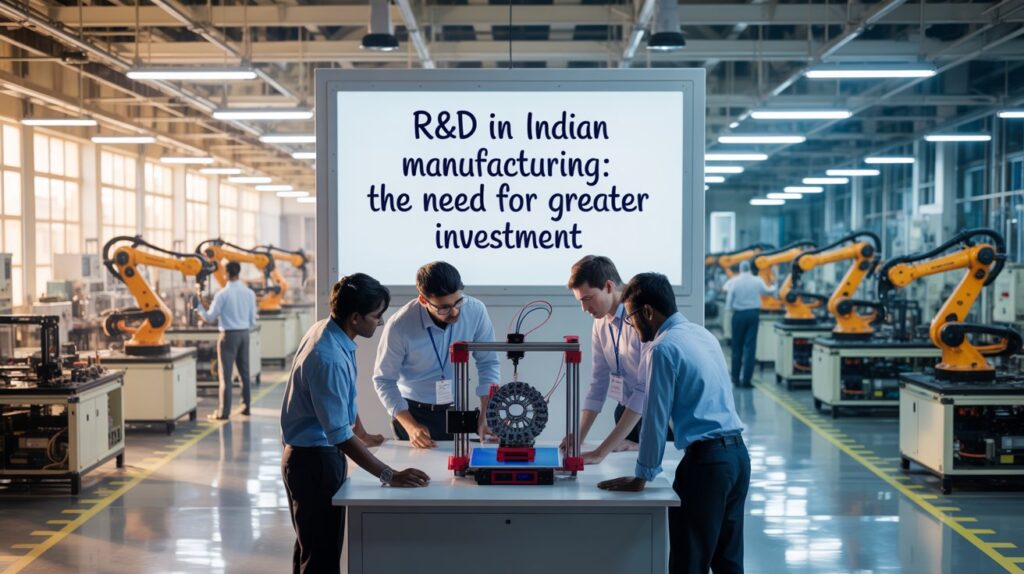
While India looks to reinforce its status as a manufacturing powerhouse in the global sphere through the ‘Make in India’ program, the role of research and development (R&D) as an innovation and competitiveness driver comes under the spotlight.
With manufacturing accounting for 17% of GDP, a far cry from the targeted 25%, India’s spend on R&D is persistently low, undermining its competitiveness against innovation-based economies.
More R&D investments are needed to enhance productivity, fulfill international benchmarks, and ensure long-term growth, but structural issues need to be resolved to realize this potential.
India’s R&D spending is only 0.7% of GDP, well behind global leaders China (2.4%), the United States (3.5%), and South Korea (4.8%), a 2024 UNESCO report states.
In industry, where innovation is key to efficiency and product differentiation, the disparity is dramatic.
A 2023 Confederation of Indian Industry (CII) study concluded that just 3% of Indian manufacturers spend over 5% of their budgets on R&D, whereas 10-15% is spent on this in developed economies. This shortfall constricts innovation in key sectors such as electronics, pharma, and auto, where competition is fierce worldwide.
In spite of the meager expenditure, islands of achievement show R&D’s promise.
The country’s third-largest volume sector, the pharmaceutical industry, invests 8-10% of revenues in research and development, which allows it to provide 62% of all global vaccines and make affordable generics, according to the Department of Pharmaceuticals.
Firms such as Dr. Reddy’s Laboratories have led the development of complicated biosimilars, cutting imports of APIs. In electronics, the Production-Linked Incentive (PLI) scheme has triggered R&D, with companies such as Tata Electronics investing in chip design for 5G uses.
Government efforts are paving the way. The National Research Foundation (NRF) with a five-year Rs. 50,000 crore outlay plans to increase industry-academia collaboration.
The PLI scheme encourages R&D in 14 sectors, and the Atal Innovation Mission provides incubators with a focus on R&D for 10,000 startups.

Cluster-based initiatives, such as the chemical clusters of Gujarat, offer collaborative R&D facilities, lowering costs for Micro, Small, and Medium Enterprises (MSMEs), which produce 45% of manufacturing output. In Tamil Nadu, the Automotive Research Association of India (ARAI) works with MSMEs to create EV technologies, saving innovation costs by 20%, according to a report in 2024.
However, reality lags behind India’s aspirations. Low R&D intensity of the manufacturing industry—0.5% of sales as opposed to 5-7% in China—restricts technological progress. MSMEs, which provide employment for 111 million people, are severely challenged, with just 2% conducting formal R&D activities owing to high expenditure and lack of access to finance, according to a 2024 SIDBI report.
Shortages of skills are a bottleneck; only 10% of the workforce is Industry 4.0-ready in technologies such as AI and IoT, as per Nasscom. X post by @EconObserverIndia condemned the absence of tax concessions for R&D, citing India’s 150% weightage tax deduction for R&D as less competitive than Singapore’s 200%.
Infrastructure deficits further delay progress. Unreliable power supply in Tier 2 cities like Kanpur interrupts R&D centers, and the scarcity of sophisticated testing labs compels manufacturers to use expensive foreign services.
Regulatory hassle, in the form of slow-moving patent approval procedures—averaging 4-6 years versus China’s 2 years—deter innovation. Global ESG norms put the squeeze on with 40% of Indian manufacturers finding it difficult to adopt sustainability standards because of outdated technologies, according to a 2024 Deloitte study.
The reorientation of the global supply chain provides an opportunity window. As companies diversify away from China, India’s innovation capability in high-value areas such as semiconductors and green hydrogen is paramount.
For example, Reliance Industries’ investment in R&D in solar and hydrogen technology has drawn in global partnerships, making India a renewable energy player. But if India does not expand R&D, it will be losing out to rivals such as Vietnam, where import duties are lower and regulatory clearances are quicker.
To fill the gap, experts recommend a multi-faceted approach. Bringing R&D expenditure to 2% of GDP, as suggested by the Economic Advisory Council, would place India on par with emerging economies. Public-private partnerships such as those in Hyderabad’s Genome Valley are able to split R&D expenditures.
Relaxing tax incentives and simplifying patent procedures would attract private investments.
Adapting academia-industry interfaces through schemes like NRF and Skill India can overcome skill deficits. In investments in digital infrastructure, e.g., 5G and cloud computing, can contribute to improving R&D efficiency, particularly for MSMEs.
Increased R&D spending is not negotiable for Indian manufacturing to reach global competitiveness.
Through its creation of innovation, cost reduction, and sustainability objectives, India has the ability to leverage its demographic dividend and value chain positioning in the world to become a leader in global supply chains.
As the country aims for $2 trillion exports by 2030, increasing R&D will decide whether ‘Make in India’ is a global champion or a work in progress.
